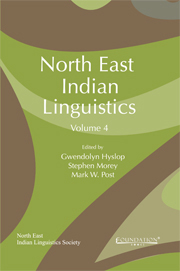Book contents
- Frontmatter
- Contents
- About the Contributors
- Foreword
- A Note from the Editors
- History, Contact and Evolution
- Bodo-Garo Grammar
- Orthography, Poetics and Text
- New Descriptions
- 10 Notes on Usoi Tripura Phonetics and Phonology
- 11 Phonological Description of the Hajong Language
- Classifiers
- Eastern Indo-Aryan Grammar
- Austroasiatic
10 - Notes on Usoi Tripura Phonetics and Phonology
from New Descriptions
Published online by Cambridge University Press: 05 May 2013
- Frontmatter
- Contents
- About the Contributors
- Foreword
- A Note from the Editors
- History, Contact and Evolution
- Bodo-Garo Grammar
- Orthography, Poetics and Text
- New Descriptions
- 10 Notes on Usoi Tripura Phonetics and Phonology
- 11 Phonological Description of the Hajong Language
- Classifiers
- Eastern Indo-Aryan Grammar
- Austroasiatic
Summary
Introduction
Usoi is a southern variety of Tripura/Kokborok, a member of the Boro-Garo branch of the Tibeto-Burman language family. It is spoken in the Chittagong Hill Tracts (henceforth CHT), Bangladesh, and in the neighboring Indian states of Tripura and Mizoram as well as in the Rakhine state of Burma. The population of Usoi speaking people in CHT is estimated to be ca. 20,000 (Kim et al. 2007: 9). In India, Usoi is a scheduled tribe and the corresponding population is 1,295 (1981 Census). The population figure is not available for Burma.
Usoi is divided into two major dialects that correspond to two major rivers in CHT: Karnaphuli and Sangu. Although there do exist differences between these two dialects, they are not so divergent that they are mutually unintelligible. My consultant of the present study is originally from Roanchari region in the Karnaphuli basin and now lives in Bandarban, the district headquarters in the Sangu basin. Usoi is highly influenced by Marma, a dialect of Arakanese/Burmese and a lingua franca in the Bandarban district of CHT. As a result, there are many Marma loanwords in Usoi.
Usoi is most similar to Reang/Riang, another southern variety of Tripura/Kokborok; however, there is virtually no linguistic data on Reang/Riang except for Riyang (2007), and the exact linguistic relationship between Usoi and Reang/Riang is unclear. While there are several linguistic descriptions of Kokborok (Karapurkar 1972; Pai 1976; Jacquesson 2003; Jacquesson 2008, etc.) including reliable dictionaries (Debbarma 2001; Debbarma 2002), there are hardly any linguistic reports on Usoi, except for Walsh (n.d.; the 1960s), Kim et al. (2007) and Huziwara (2008).
- Type
- Chapter
- Information
- North East Indian Linguistics , pp. 197 - 215Publisher: Foundation BooksPrint publication year: 2012



